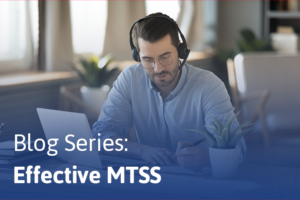BLOG SERIES: EFFECTIVE MTSS
Step 5: Train your Staff in the MTSS Model
Part 5 of virtual learning expert and Pulse user Chris Loiselle’s blog series

- Addresses a relevant and useful topic
- Has significant opportunity for hands-on engagement
- Multiple learning strategies involved – kinesthetic, visual, auditory, etc.
- Has clear goals and expectations from the experience – communicated both before and after to ensure closure
- Provides opportunity for colleague connection and teamwork time
- Provides some take-away tools and resources
These are only a few key ingredients that the school we observed planned into their MTSS training session with staff.
The school wanted to ensure that the PD session was relevant and engaging. They decided to poll staff in advance to identify student profiles for use in their MTSS strategy development activities. They created 6 different profiles of actual student situations for use during their PD sessions.
The first step during training was to walk the staff through the new MTSS Handbook. They used the handbook as the basis for the training session. It describes the purpose and process of MTSS first, and all staff were provided a copy of a new tracking worksheet being used to support the MTSS effort – the General Education Support Plan (GESP). We’ll describe the layout and function of the GESP in a following blog post.
Once the staff were introduced to the purpose of MTSS, the GESP, and the Support Strategies Implementation Guide, it was time for some hands-on activities. Staff were assigned to various tables, and at least one member of each staff type was assigned to each table (Gen Ed teacher, para-pro, administrator, social worker, SPED teacher, and office staff member). The idea was to ensure that all staff, regardless of role, had something to add in support of students. Next, each table was given one student scenario to read. Finally, the team was asked to develop a GESP for that student and present it to the entire PD group afterward. Each member of the table had to think about how they could have contributed or supported the support plan and effort.
Following the PD session, the PD planners asked for feedback on the session through an anonymous survey. Many staff members commented that it had been one of the best training/PD sessions they had experienced. It was deemed a success with the administration and accomplished the goal of introducing the MTSS purpose and process to all staff. Now it was time for implementation.
Next: Step 6: The Validation and Certification Process — Use of the GESP

Since 2011 Chris Loiselle has worked as building administrator, CFO, and Chief Strategic Officer for Success Virtual Learning Centers and Berrien Springs Public Schools, where he is currently filling the Director of Quality Assurance role. While working at Success, Chris was instrumental in the development of the Pulse student support software. His passion is working in K-12 managing e-learning centers and building software to help improve virtual learning outcomes.
Chris first presented this 6-step process for effective MTSS at the Digital Learning Annual Conference in Atlanta, in February 2022.
His goal is to be able to help people prosper and succeed in today’s challenging educational environment.

